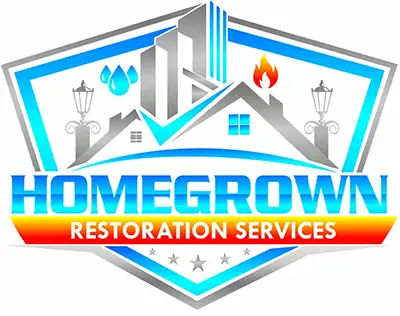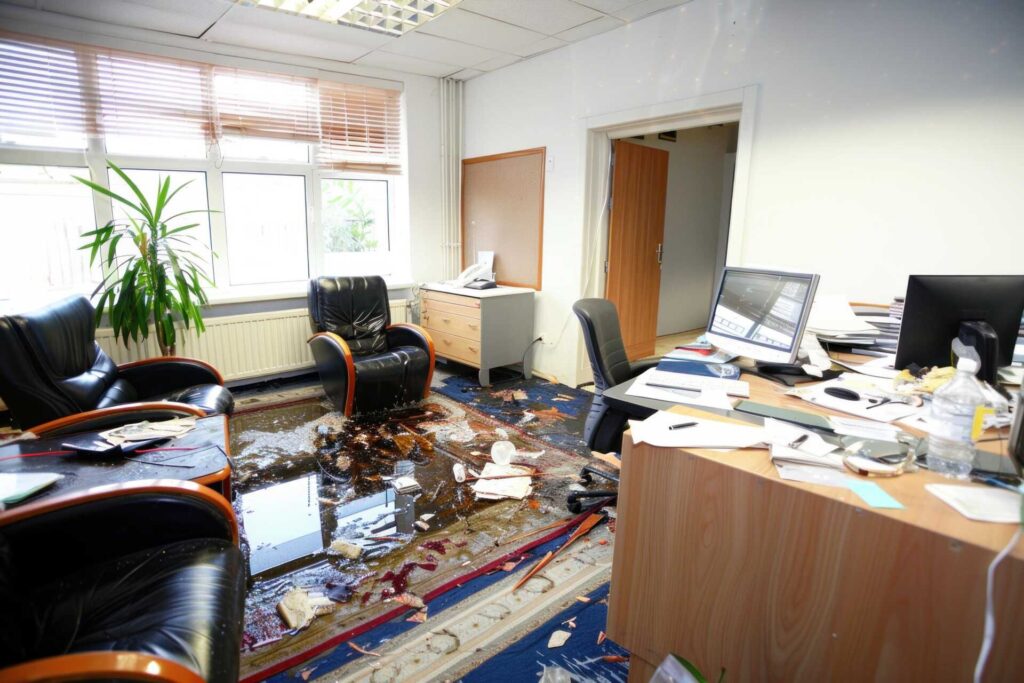When faced with a sewage cleanup disaster in your commercial office, you’ll need to act quickly, efficiently, and safely. First, make certain you’re equipped with the right gear and knowledge to protect yourself and your team. It’s vital to assess the extent of the damage and choose the most effective removal and disinfection techniques. But what happens next? How do you maintain a clean and safe environment post-cleanup, and what are the best practices for preventing future incidents? Let’s explore the necessary steps and considerations to keep your workspace safe and operational.
Key Takeaways
- Document damage extensively, including photos and notes, for insurance claims and detailed assessments.
- Equip staff with protective gear like waterproof gloves and respirators to ensure safety during cleanup.
- Use wet vacuuming and submersible pumps for efficient sewage removal, adhering to waste management regulations.
- Apply EPA-approved disinfectants on affected surfaces, ensuring ventilation to aid in fume dissipation and drying.
- Prevent future incidents by maintaining a regular schedule for pipe and drainage inspections and cleanings.
Assessing the Damage Extent
Before you immerse yourself in the cleanup, it’s important to thoroughly evaluate the extent of the damage caused by the sewage spill. You’re not alone in this; everyone in your community of fellow business owners understands the challenges that come with property management, especially in emergencies like this.
Begin your damage evaluation by documenting everything meticulously. Take photos and make detailed notes of all affected areas. This evidence is critical for both understanding the full impact and for future insurance considerations.
When evaluating the damage, focus on areas where water has infiltrated—these could range from subfloors and insulation to electrical systems and furniture. Water from sewage spills isn’t merely a mess; it’s a contaminant that can pose serious health risks, complicating the cleanup process. You want to ensure that your approach to evaluating the damage aligns with safety regulations and compliance standards, protecting your property and your health, and that of your employees.
Next, review your insurance policy closely. It’s crucial to know what’s covered and what isn’t. Many policies include specific clauses about sewage spills, and understanding these details can greatly affect how you approach the cleanup and what resources you can access.
Don’t hesitate to contact your insurance representative to clarify any doubts. They’re there to help you navigate through these tumultuous times.
Safety Protocols and Equipment
Having reviewed your insurance policy and assessed the extent of damage, it’s important to focus on the implementation of rigorous safety protocols and securing the right equipment for the sewage cleanup. Before you engage in the cleanup, conducting a thorough hazard assessment is vital. You’ll need to understand the specific risks associated with the sewage spill in your commercial space to effectively protect everyone involved.
First, verify that all personnel are equipped with the necessary protective gear. This includes waterproof gloves, boots, eye protection, and face masks or respirators, specially designed to prevent contact with harmful contaminants. Remember, this isn’t merely about compliance; it’s about ensuring the safety and well-being of your team.
Here’s a breakdown of essential safety equipment and its purpose:
| Equipment Type | Purpose | Regulatory Standard |
|---|---|---|
| Waterproof Gloves | Prevent skin contact with sewage | OSHA Standard 1910.138 |
| Eye Protection | Protect against splashes | ANSI Z87.1-2020 |
| Respirators | Filter out harmful pathogens and gases | NIOSH Certification |
| Waterproof Boots | Prevent feet from contact with contaminated water | ASTM F2413-18 |
Implementing these safety measures aligns with regulatory requirements and fosters a sense of responsibility and care amongst your staff. It shows you’re committed to their health and safety, creating a protective environment where everyone feels valued and secure. As you prepare for the cleanup, keep these guidelines at the forefront to ensure a safe and efficient process.
Sewage Removal Techniques
Once you’ve established safety measures, the next step in managing a sewage spill on your commercial property is effective sewage removal. You’re part of a community that values prompt, efficient responses to such crises, ensuring minimal disruption and maximum safety for everyone involved.
The first aspect to take into account is choosing the right sewage extraction methods. Depending on the volume and accessibility of the spill, you might opt for wet vacuuming. This method is highly effective for removing liquids and solids, allowing you to handle large amounts of waste quickly. Confirm the vacuum is specifically designed for sewage to avoid contamination and additional equipment damage.
Another viable option is the use of a pump, particularly if the sewage level is substantial. Submersible pumps can be placed directly in the sewage, facilitating fast and efficient removal. It’s vital to select a pump that can handle the size and type of debris typically found in sewage to prevent clogging and breakdowns.
Incorporating wastewater management solutions is also essential. Properly managing the extracted sewage is a regulatory requirement as well as a commitment to your community’s health and environmental safety.
This involves transporting the waste to a designated treatment facility where it can be processed and disposed of according to local environmental standards.
Disinfection and Sanitization Steps
After removing the sewage, your next step is to thoroughly disinfect and sanitize the affected areas of your commercial property. This is essential to ensure the safety and well-being of everyone who belongs to your office community.
Start by choosing EPA-approved disinfection methods that are effective against a broad spectrum of bacteria and viruses. These methods will help you meet health standards and reassure your team that their workspace is safe.
Use sanitization products that are specifically designed for the type of surfaces in your office. For non-porous surfaces such as tiles and countertops, use a strong disinfectant that can kill pathogens quickly. Apply the disinfectant according to the manufacturer’s instructions, usually by spraying or wiping the surfaces, and allow it to sit for the recommended dwell time to maximize effectiveness.
For porous surfaces like carpets and upholstery, which are more challenging to clean, opt for products that can penetrate deep and neutralize odors as well as eliminate contaminants. These areas might require multiple treatments or specialized equipment such as steam cleaners that can reach deeper layers.
Always wear protective gear, including gloves, masks, and goggles, during the disinfection process. This keeps you safe from harmful chemicals and prevents any direct contact with leftover contaminants.
Dispose of any cleaning materials like cloths and mop heads in a safe manner to avoid the risk of cross-contamination.
Lastly, ensure that the space is well-ventilated throughout the cleaning process. This helps to clear out any fumes from disinfectants and accelerates the drying process, bringing your office back to a pristine, welcoming state sooner.
Preventing Future Sewage Issues
To prevent future sewage issues in your commercial property, it is vital to implement regular maintenance and monitoring of your sewage system. By staying proactive, you are safeguarding your property and ensuring the safety and well-being of everyone who steps foot in your building.
Regular maintenance is key. This includes routine inspections and cleaning of pipes and drainage systems to prevent blockages and leaks that could lead to larger issues. It is important to establish a schedule for these activities and adhere to it strictly. Incorporating advanced monitoring technologies can also alert you to potential problems before they escalate.
Emergency preparedness is another significant element. Having a response plan in place ensures that if sewage issues do arise, they can be addressed quickly and efficiently, minimizing damage and disruption. Train your staff on this plan, making sure everyone knows their role in an emergency.
Here’s a simple table to help you keep track of what’s needed:
| Activity | Frequency | Responsible Party |
|---|---|---|
| Pipe Inspection | Bi-Annually | Maintenance Team |
| Drain Cleaning | Quarterly | Plumbing Services |
| Emergency Drills | Annually | Safety Coordinator |
Review
Well, congratulations! You’ve slogged through the muck of sewage cleanup in your commercial office. Remember, always suit up like you’re entering a biohazard zone—which you are. Keep using those high-tech slurp-up machines and don’t skimp on the bleach! Make it a ritual, like morning coffee, to check those pipes and keep your space from turning into a swamp again. Here’s to creating a spotless, odor-free office paradise, or at least something close to it!

